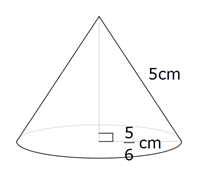Forum Replies Created
-
AuthorPosts
-
in reply to: Quadratic Factors #8117
Fully factorise 4x4 – 13x2 + 9.
4 × 9 = 36: -9, – 4 will multiply to 36 and add to -13
= 4x4 – 4x2 – 9x2 + 9
= 4x2(x2 – 1) – 9(x2 – 1)
= (x2 – 1)(4x2 – 9)
= (x – 1)(x + 1)(2x – 3)(2x + 3)
in reply to: Trig Maxima/Minima #7653A sector has a radius r cm and contains an angle θ radians. The area of the sector is 100 cm2.
a. Show that perimeter P cm of the sector is given by $$P= 2r +\frac{ 200}{r}$$.
b. If r and θ vary in such a way that the area of the sector remains constant at 100 cm2, find the values of r and θ which give the least value of P.a. A = ½r2θ = 100
r2θ = 200
$$\theta=\frac{200}{r^2}$$P = arc length + r + r where L = θr
$$P = \theta\times r+ 2r$$$$P=\frac{200}{r^2}\times r+ 2r$$
$$P =\frac{200}{r}+2r$$
b. P = 200r-1 + 2r
P’ = -200r-2 + 2
P”= 400r-3
P’ = $$\frac{-200}{r^2}+2=0$$
$$\frac{-200}{r^2}=-2$$
-200 = -2r2
100 = r2
r = ±10
consider r = 10 (as we can’t have negative gradients)
when r = 10
P”=$$\frac{400}{10^3}>0$$
∴ concave up, hence minimum
when r = 0
$$\theta=\frac{200}{10^2}$$
θ = 2
∴ minimum when r = 10 and θ = 2
Using the tax table below, calculate the taxable income if $25,416 was paid in tax.
TAXABLE INCOME TAX $1 – $8,000 Nil Nil $8,001 – $23,600 Nil 16c for each $1 in excess of $8,000 $23,601 – $65,000 $2,496 30c for each $1 in excess of $23,600 $65,001 – $97,000 $14,916 42c for each $1 in excess of $65,000 $97,001 and over $28,356 48c for each $1 in excess of $97,000 Find the tax bracket, which will have to be the $65,001 – $97,000, as the one below is too high.
25,416 = 14,916 + 0.42(x – 65,000) subtract 14,916 from both sides
10,500 = 0.42(x – 65,000) divide both sides by 0.42
25,000 = x – 65,000 tadd 65,000 to both sides
x = 90,000
∴ Taxable Income was $90,000
in reply to: Arc lengths, Sectors & Segments #906A sector of a circle with radius 5cm and an angle of subtended at the centre is cut out of cardboard. It is then curved around to form a cone. Find its exact surface area and volume.
the arc length will form the circumference of the cone, and the radius will form the slant height
ℓ = $$5 \times \frac{\pi }{3}$$
C = $$\frac{{5\pi }}{3} = 2\pi r$$
r = 5/6
h2 = 52 – (5/6)2
h2 = $$\frac{{875}}{{36}}$$
h = $$\frac{{5\sqrt {35} }}{6}$$
$$V = \frac{1}{3}\pi \times {\left( {\frac{5}{6}} \right)^2} \times \frac{{5\sqrt {35} }}{6}$$
$$V = \frac{{125\sqrt {35} \pi }}{{648}}cm^3$$
$$SA=\pi\,r^2+\pi\,r\,l$$ where L is the slant height
$$SA = \pi \times {\left( {\frac{5}{6}} \right)^2} + \pi \times \frac{5}{6} \times 5$$
$$=\frac{{175\pi }}{{36}}cm^2$$
A particle moves along the x-axis with an acceleration given by a = 6t + 3. When t = 0, x = 5 and the velocity of the particle is 1 unit per second. Find the position of the particle after 3 seconds.
v = $$\frac{{6{t^2}}}{2} + 3t + c$$
v = 3t2 + 3t + c
when t = 0, v = 11 = 3(0)2 + 3(0) + c
c = 1 v = 3t2 + 3t + 1
x = $$\frac{{3{t^3}}}{3} + \frac{{3{t^2}}}{2} + t + k$$
x = $${t^3} + \frac{{3{t^2}}}{2} + t + k$$
when t = 0, x = 5
5 = 0 + 0 + 0 + k k = 5
∴ $$x = {t^3} + \frac{{3{t^2}}}{2} + t + 5$$
when t = 3
x = 27 + 27/2 + 3 + 5
= 48.5
Attachments:
You must be logged in to view attached files.in reply to: Relationship between Roots and Coefficients #535One root of the equation x2 – 6x + c = 0 is twice the other root. Find the value of c.
let α = 2β
α + β = –-6/1
α + β = 6
2β + β = 6
3β = 6
β = 2
αβ = c/1
2β× β = c
2 × 2 × 2 = c
c = 8
in reply to: Relationship between Roots and Coefficients #5343x2 + kx + 4 = 0 : one root is three times the other. Find the 2 possible values of k.
let β = 3α
α +β = –k/3
α + 3α = –k/3
4α = –k/3
α = –k/12
αβ = 4/3
3α2 = 4/3
3( –k/12)2 = 4/3
$$\frac{3k^2}{144} =\frac{4}{3}$$
k2 = 64
k = ±8
in reply to: Relationship between Roots and Coefficients #15708Consider P(x) = x³ – 3x – k.
a. If P(0) < 0 and P(2) > 0 show that 0 < k < 2.
b. If k = 1 show that the equation P(x) = 0 has three real roots.
a. P(0) < 0 then
x3 – 3(0) – k < 0
-k < 0 k > 0
and
P(2) > 0 then
23 – 3(2) – k > 0
8 – 6 – k > 0
-k > -2
k < 2
hence 0 < k < 2b. x3 – 3x – 1 = 0
easiest way to prove this is with calculusy’ = 3x2 – 3 = 0
y’ = 3(x2 – 1) = 0
3(x – 1)(x + 1) = 0
x = -1 and x = 1
(-1, 1) and (1, -4)
since a cubic with one turning point above the x-axis and one turning point below the x-axis
there must be three roots(a cubic can have 1 root: both turning points above or below the x-axis
2 roots: one turning point on the x-axis and one either above or below the x-axis
3 roots: one above and one below the x-axis) -
AuthorPosts



